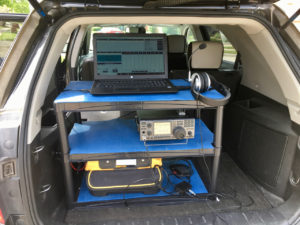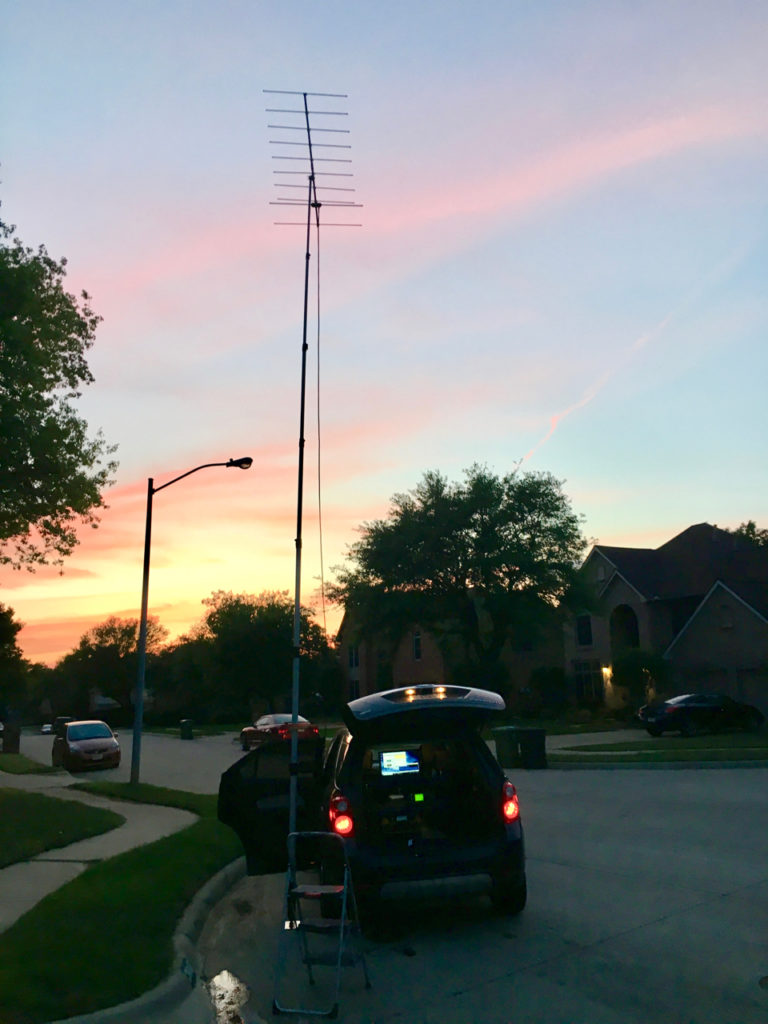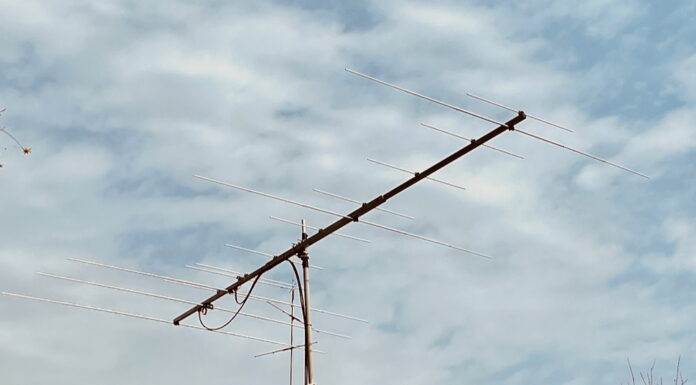144 MHz Spring Sprint Results
The activity here in North Texas for this event is usually very low. After the first hour there’s not much to do. During that first hour, I managed to work five stations and each was a new multiplier. I did hear another station but they were very weak and didn’t hear me.
Thanks to W5LUA (EM13), W5AAC (EM10), K5VH (EM00), W5VTM (EM25), and WB5KGL (EM12) for the contacts. Tried to get W0RT in EM27, a new grid and state for me, but no luck.
Rover Station Setup — Push Up Mast
As you may recall, my home push up mast got bent up in the wind and needed to come down. So apart from my HF vertical, I’m operating satellites and VHF-UHF contests as a rover — even when I’m at home.
To support that effort I ordered a Max-Gain Systems MK-4-HD 25 foot fiberglass push-up mast along with their Heavy Duty Mast Mount with Tilt-Lock. I also ordered their guying system consisting of the guying rings, dacron rope, and guy rope tensioners.
 Nearby you can see the full set up, without guying, on my car ready for the sprint. I really like the solid set up and ready activation of the mast. I particularly like the teflon support in the mast mount that allows very easy rotating of the mast. Note, too, my cargo rack support system. This allows greater stability even without guys.
Nearby you can see the full set up, without guying, on my car ready for the sprint. I really like the solid set up and ready activation of the mast. I particularly like the teflon support in the mast mount that allows very easy rotating of the mast. Note, too, my cargo rack support system. This allows greater stability even without guys.
I did, however, encounter a few problems.
First, the fiberglass mast sections arrived nested together in a box, but I couldn’t get two of the mast sections separated. So I had to use a piece of wood to literally pound the inner tube out. Once out, I found that it could slide in and out, not quite all the way in, but at least it fit except for about 15 inches. On contact with Max-Gain Systems they reported that a mast section can sometimes be slightly oval and would best fit with a slight turn to match the ovals. I found that to be true, but still couldn’t fully retract that particular tube. It’s now at roughly 8 inches from fully nesting. Perhaps over time and some back and forth movement, that will improve still further.
Second, the tilt over unit holes didn’t match the base or the mast sleeve. They were just too close together to allow the bolts to fit at all. So I used a rat-tail file to elongate the holes on the tilt over unit and get them to work. It all comes together nicely now.
In retrospect, I’m not sure I needed the tilt over unit. That’s exactly how I used my rover set up with a painter pole, but with this system the mast pushes up very nicely and no tilt over mounting is really needed. Something for you to consider if you’re thinking of purchasing this system.
Rover Station Setup — Operating Position
This was also an opportunity to rework my operating position. For past rover operations I used a 2006 Saturn Vue. It allowed the front passenger seatback to fold over and form a perfect operating position from the back seat. With 155,000 miles on it, my wife and I decided it should be retired and replaced. We bought a 2018 Honda CR-V, but not for my rover vehicle. So now I’m running our 2011 Chevrolet Equinox with only 100,000 miles on it.
 The configuration uses some low-cost shelves from Home Depot with the legs holding up the shelves cut to fit the equipment. The bottom shelf holds the battery, the middle shelf holds the rig, and the top shelf holds the laptop. To the side is space to stow the mast and antennas. The shelves are covered with a cut down yoga mat. This should help prevent them from sliding off during driving.
The configuration uses some low-cost shelves from Home Depot with the legs holding up the shelves cut to fit the equipment. The bottom shelf holds the battery, the middle shelf holds the rig, and the top shelf holds the laptop. To the side is space to stow the mast and antennas. The shelves are covered with a cut down yoga mat. This should help prevent them from sliding off during driving.
The battery on the bottom shelf provides a solid base, but I will also anchor the unit with some bungee cords to the side of the car. This setup provides a stand-up position with easy access to the mast, which is armstrong rotated. Plus, the back door provides a sun cover. Not sure what I’ll do if it’s raining. I do like the standup position as a nice contrast from the driving position between grids. I also don’t have to contort my position as much to look at the antenna to verify where it’s pointing. I will take along a step-ladder for antenna set up. So it can serve as a stool when needed.
Here’s the full system in action, well at least listening, at the end of my hour of effort for the 144 MHz Spring Sprint.









